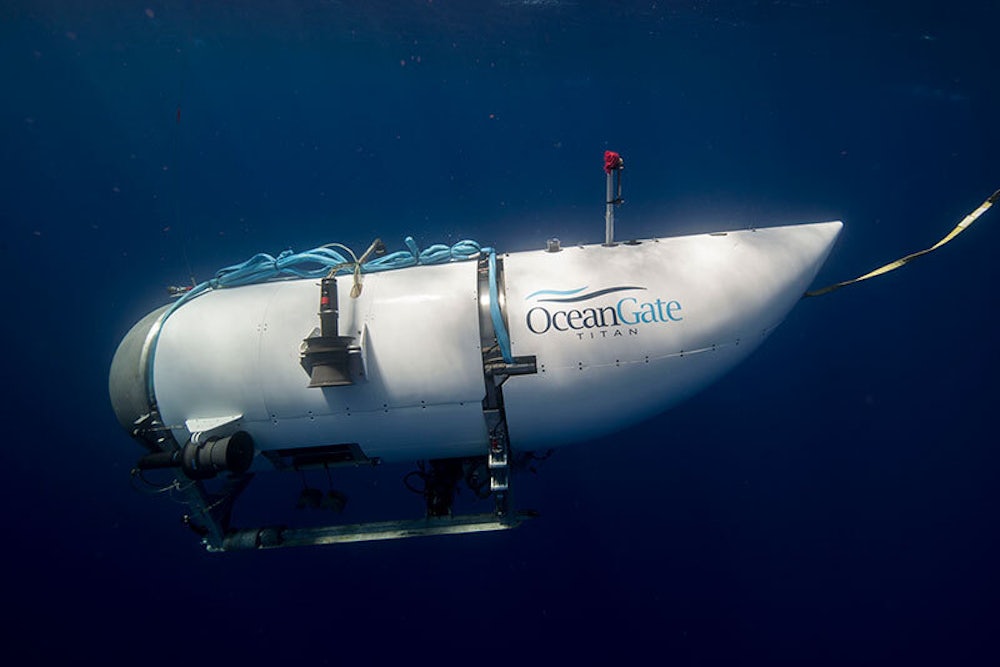Somewhere in the North Atlantic a tiny submersible with five people on board is drifting helplessly, possibly thousands of feet below the surface. The passengers are rich tourists, including a British explorer and a Pakistani businessman, who had paid $250,000 to visit the remnants of the Titanic, which sank 111 years ago and sits nearly 13,000 feet below sea level. The submersible is itself an object of curiosity. Concerns about its durability were raised in a 2018 lawsuit that alleged it could not safely travel the ocean’s depths. It is, despite the exorbitant cost of what was supposed to be a short trip, almost comically shoddy, bolted together with parts intended for R.V.s and piloted with a video game controller.
This short clip will help you understand why the Titanic mini sub is missing and why this was an accident waiting to happen. pic.twitter.com/srrXmFnoTq
— Frida Ghitis (@FridaGhitis) June 20, 2023
The submersible’s disappearance has arguably been the biggest news story of the last 24 hours. That’s understandable in some ways. For one thing, it’s a mystery: No one knows where it is or what state its passengers are in. There is, moreover, a race against time, as the sub has enough oxygen to make it until early Thursday, according to the Coast Guard—if, that is, the passengers are even still alive. There is both the possibility of an improbably happy ending or of unspeakable tragedy—another element of a compelling news story. And then there’s everything about the janky sub and its rich passengers, who have risked their lives on what is essentially a novelty expedition. Without knowing their fate, it has the feeling of something out of a Ruben Östlund film: These people are so wealthy they can take dangerous chances in a vessel the size of a Honda Odyssey, just for thrills.
Coverage of the missing submersible unintentionally illustrates something even more tragic, however. On June 14, what was likely the second-deadliest refugee and migrant shipwreck on record occurred when a boat carrying as many as 800 migrants sank off the Greek coast. Greek authorities had tracked the vessel, and early signs suggest the country’s coast guard was slow to act despite numerous warning signs. This is a huge news story, one that hits at both Europe’s ongoing refugee crisis and the callousness with which many European nations treat migrants who are desperately trying to reach their shores. Yet it has received scant attention in the American media—and the missing submersible story has dwarfed what coverage there has been.
That the deaths of hundreds of migrants hasn’t reached the level of a missing submersible packed with rich tourists showcases a number of American media deficiencies. The Titanic submersible is a “new” news event—it is, after all, not every day that a few fabulously wealthy people go missing at the bottom of the ocean in an underwater vehicle that looks like a septic tank. It is, as noted above, also an ongoing news event with a compelling mystery: As of this writing (Tuesday afternoon) its ending is still unknown. It has a bit of the feel of the Malaysia Airlines flight 370 story from a few years ago—a tragedy and a mystery woven together—just with far fewer (and far richer) passengers.
And yet what does the story tell us about the way the world works? It says something that the submersible is unregulated and was not checked by any nautical safety agency; the fact that there are people who can drop this kind of money to travel to the bottom of the ocean for fun says something too, I suppose. It is a story that undeniably highlights something about our contemporary world, where some people are wealthy enough that they can lay out a quarter of a million to visit the bottom of the ocean on a lark.
But these are and have been minor facets of the incident’s coverage, even if they undoubtedly are a part of what is driving the public’s fascination. Instead it’s been covered the way many breaking news stories are, with updates trickling in about the (possible) victims, items being written up with the bits of information that have come from press conferences, and a general sense that it is a story whose intrinsic importance commands the public’s unblinking attention.
The sinking of a boat carrying hundreds of migrants should be treated this way, but it isn’t and hasn’t been. It is undoubtedly a new story and an unspeakably tragic one—it’s also, unlike the Titanic tourists story, one that says a great deal about the way the world works. And yet it’s treated as routine or even mundane—yet another faceless tragedy involving people who typically receive far less attention than those who are far better off than they are. There’s greater appetite for coverage of lifestyles of the rich and (now) famous than for the deaths of hundreds of anonymous migrants, or at least cable news assignment editors think so. The story is undoubtedly political as it involves immigration policy, various European governments, and the conditions that drive people to take extraordinary risks to go on hazardous journeys across the Mediterranean. And yet much of the coverage that does occur fails to address these complexities.
The deadliest migrant and refugee shipwreck occurred in April 2015, when a boat carrying as many as 1,100 people traveling from Libya to Italy capsized in the Mediterranean. Later that summer, a haunting image of a young boy’s drowned body washed up on a Turkish beach went viral after the boat that had been carrying him and his family capsized. Migrants and refugees have continued to arrive in Europe since then; boats carrying them have tragically continued to sink. And yet news coverage in the United States has largely dried up. The American media has moved on, particularly after the rise of Donald Trump. Attention never returned to the levels it did that summer, even though migrants have continued to take extraordinary risks to go to Europe.
Some of this is just because the American press has always struggled to cover international stories without an obvious U.S. angle. Some of this is undoubtedly a reflection of the ratings-obsessed nature of cable news and the traffic-obsessed nature of online media, which both tend to gravitate toward viral stories like the Titanic submersible and away from complex international ones like what happened off of Greece last week. And this all highlights a larger aversion to cover difficult stories, particularly difficult international ones.
The missing submersible only underscores these deficiencies. With luck, its passengers will be found alive. But it also showcases a press that will rapidly turn its attention to some issues while leaving other glaring omissions in its coverage. News outlets have, over the last 36 hours, devoted extraordinary resources to covering five missing people trapped in a metal tube. They could have devoted similar resources to the ongoing fallout surrounding the deaths of hundreds of migrants—they simply haven’t.










